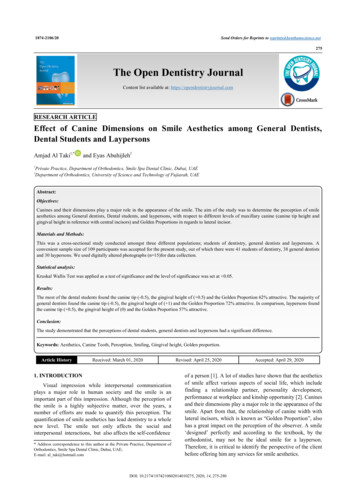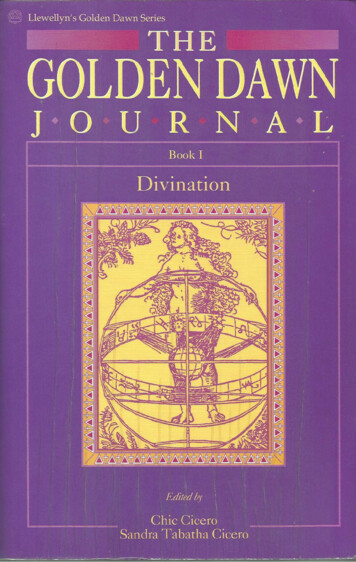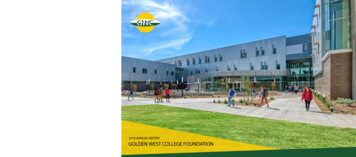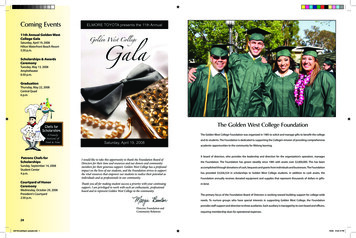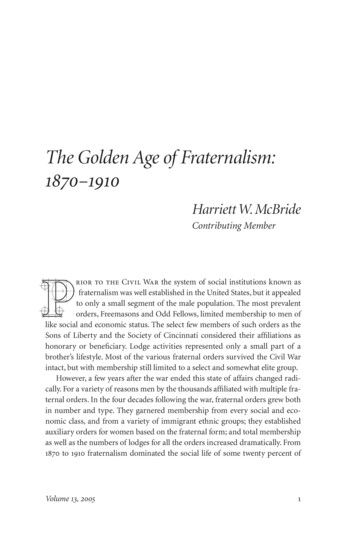
Transcription
The Golden Age of Fraternalism: – Harriett W.McBrideContributing MemberPrior to the Civil War the system of social institutions known asfraternalism was well established in the United States, but it appealedto only a small segment of the male population. The most prevalentorders, Freemasons and Odd Fellows, limited membership to men oflike social and economic status. The select few members of such orders as theSons of Liberty and the Society of Cincinnati considered their affiliations ashonorary or beneficiary. Lodge activities represented only a small part of abrother’s lifestyle. Most of the various fraternal orders survived the Civil Warintact, but with membership still limited to a select and somewhat elite group.However, a few years after the war ended this state of affairs changed radically. For a variety of reasons men by the thousands affiliated with multiple fraternal orders. In the four decades following the war, fraternal orders grew bothin number and type. They garnered membership from every social and economic class, and from a variety of immigrant ethnic groups; they establishedauxiliary orders for women based on the fraternal form; and total membershipas well as the numbers of lodges for all the orders increased dramatically. From to fraternalism dominated the social life of some twenty percent ofVolume ,
Harriet W. McBrideAmerican males, while a significant percentage of America’s women alsofocused their social interactions around fraternal auxiliaries and sisterhoods.Membership in Eastern Star, Rebekah, the Daughters of Ruth, or the PythianSisters was every bit as important as membership in church circles and literaryguilds. Contemporary observers termed this phenomenal rush to join secretsocieties “The Great Fraternal Movement,” and students of the movementreferred to this time period as “The Golden Age of Fraternalism.”As early as scholars acknowledged the phenomenon and attempted tofind a cause or explanation for this uniquely American pattern of social behavior. Historians, sociologists, and philosophers have analyzed fraternalism fromvarious perspectives and have suggested multiple reasons for the rise anddemise of the Great Fraternal Movement.¹ One area of social behavior whichhas not yet been sufficiently considered as a factor in the movement is that ofdress. The purpose of this essay is to examine the use of clothing by fraternalorders during the forty years from to and to consider the notion thatincreased use of regalia and non-normative forms of dress and body adornment contributed to the Great Fraternal Movement—that men (and women)joined fraternal orders and created new orders, ranks, ceremonies, and ritualsto wear fraternal regalia.A comparison of manuals from the first half of the nineteenth century withthose from the last third of the century show that the nature of fraternalismchanged drastically with regard to the use of garments and accessories of dress.²Secret societies experienced an overwhelming concern with clothing. As fraternalism increased in size and influence, so did the use of clothing and regalia.Artifacts of dress became a very public identifying feature of the secret societies. The amount and types of clothing, and the frequency of use of clothing infraternal rituals changed during this time, as did the manner in which clothingwas used. Lodge activities and rituals formerly conducted with improvised,symbolic garments and accessories now required extensive use of ornate robes,cloaks, special headgear, specific accessories, theatrical costumes, and militaryuniforms. Governing bodies of the orders considered regalia an importantissue—the defining element of the fraternity’s image, both public and private.Leaders hotly debated the subject of regalia, while the rank-and-file membership engaged in lengthy discussions about uniforms, costumes, gloves, aprons,and headwear.³ Without doubt, dress served as an identifying feature of theGolden Age of Fraternalism and as a contributing factor that influenced men tojoin secret societies in such great numbers. Heredom
The Golden Age of Fraternalism: 1870–1910Fraternalism During the Civil WarAs the first cannon fired on Fort Sumter in , leaders of fraternal orders (Freemasonry in particular) concerned themselves with regaining respectability andopen public acceptance for the institutions. Following the debacle of the MorganAffair in and the subsequent rise of the politically motivated Anti-MasonicParty, lodge membership and active participation in fraternal activities declineddrastically. However, by the Anti-Masons held no significant political influence, and the brethren returned slowly to the sacred meeting places. Initially, asthe lodges reconvened, attendance was small—some older members had died,others dropped their affiliations, and recruitment was a slow process. Only asmall segment of American men actively and openly participated in fraternalactivities, but membership was on the rise, and was no longer something to hide.The American Civil War interrupted and slowed the growth of fraternalorders in this country, but it did not destroy the secret societies. Smaller fraternities such as the Druids and the Redmen simply held their activities in abeyanceuntil the end of the war. A few of the less serious fraternal societies, such as theSons of Malta disappeared during the conflict and never revived.⁴ The larger,national organizations remained active on a limited basis during the hostilities,but did not focus on recruiting new members or organizing new lodges. Further,where lodges convened on bivouacs or near battlefields, regalia mattered little.The governing bodies of the fraternities showed almost no concern for regaliaduring the war, other than to preserve and protect items owned by lodges.As hostilities raged on for four years, Freemasons and Odd FellowsF kept thefraternal spirit alive on the home front, particularly in their attentions to widowsand orphans of fallen brothers and in performing funeral rites for deceasedmembers. Regalia for these activities usually consisted of aprons, collars, andgloves. With a large part of the male population engaged in active military serviceand wearing military uniform, fraternal orders did not parade publicly in regalia.As in previous military actions (the American Revolution, the War of ,and the Mexican-American War), Freemasons in the armed services, most ofwhom were officers, convened military lodges in both Union and Confederatearmies. Such regalia as was used in military lodges consisted only of aprons andgloves, which a man could easily pack and carry. For sessions held in field tents,devoted and faithful Freemasons carried portable symbolic lodge equipment.⁵Among the civilian population, Freemasonry in the Northern states slowlyrecovered from the decline in active membership that resulted from the rise ofthe Anti-Masonic Party. Lodges acquired few new members; some older men,Volume ,
Harriet W. McBridethose not serving in the military and who had quietly withdrawn from Masonicactivities in the face of the Anti-Masonic movement, now re-affiliated.In the South, along with every other aspect of civilian social life, fraternalism suffered. Prior to , Charleston, South Carolina, had been the seat of theScottish Rite, the most elite of the Masonic bodies. As that city was isolated,besieged, burned, and devastated by Northern troops, fraternal activity cameto a halt. For a time, Scottish Rite activity in the South ceased.⁶ In New Orleans,Atlanta, Vicksburg, and elsewhere desperate people converted Masonic andOdd Fellows halls to other uses, as needed by the military and by the civilianpopulation. In both the North and the South few men were available or soinclined or had the leisure time and money to convene fraternal lodges in themidst of war. Many lodges and meeting rooms served as hospitals, canteens,and even makeshift morgues.Odd Fellowship survived the conflict and, like Freemasonry, fared better inthe North than in the South. Correspondence from Odd Fellows confirms thatthe fraternity continued to operate during the Civil War and that toward theend of the war fraternal activity increased. For the last twelve months of theCivil War, from April to April , Odd Fellowship in Ohio had a netincrease in membership of , .⁷ With the cessation of hostilities in , fraternalism revived, flourished, and became a dominant force in American malesociety for the next five decades.The Extent of the Great Fraternal MovementStatistics from the time period provide a measure of the enormity of the fraternal movement.⁸ In B. H. Meyer identified fraternal societies whose dateof organization could be ascertained and found thatonly had been founded before , between and , between and , and from to . In other words, percent of the fraternal societies are only twenty years old, nearly one-fourthare between ages of five and ten, and over per cent are either infants orchildren below five the increase during the last five years has been per cent, and during the past ten years it has doubled.⁹Only five years earlier, W. S. Harwood had estimated that over , , men belonged to at least one secret fraternal society, and that figure excluded anestimated , members of the Grand Army of the Republic.¹⁰ Both Harwood and Meyer claimed that one in five American males over the age oftwenty-one belonged to one or more secret societies at that time. Heredom
The Golden Age of Fraternalism: 1870–1910A few years later in , Albert Stevens listed in his Cyclopaedia of Fraternities seventy-eight “general fraternal orders which offer low-cost life insuranceplans to members.” These seventy-eight secret fraternal societies claimed a totalmembership of , , . Stevens added to this figure, “membership in minorfraternal orders” of , , and “total membership of [ten] secret fraternitiesof a charitable, benevolent, religious or philosophical and mystical character,but which do not include life insurance features” of , , . Stevens claimedthat since some six hundred secret societies had existed in the UnitedStates and that by of these survived. He estimated a total membershipin fraternal societies in of , , —well over forty percent of the malepopulation.¹¹ By any measure, fraternalism was an impressive social presencethroughout the last three decades of the nineteenth century and into the firstdecades of the twentieth century.During the years from through , the dominant fraternal orders interms of size, activity, and public visibility were the Grand Army of the Republic, the Masonic orders, the Independent Order of Odd Fellows, and the Knightsof Pythias. But the social movement that began in the s was not limited toincreased membership in existing fraternities. Men from a variety of backgrounds formed dozens of new fraternities that mimicked the features of theseestablished orders. Most of the American secret societies were founded after , and most of those were founded by men who already belonged to othersecret societies.¹² Members of the Masonic fraternity, the Ancient Order ofUnited Workmen, the Royal Arcanum, the Knights of Honor, and the Odd Fellows established the Royal Society of Good Fellows in .¹³ Members of theIndependent Order of Rechabites organized the Sons of Jonadab, a temperancegroup in .¹⁴ A group of Masons, Odd Fellows, and Knights of Pythias withspecial political leanings founded the Knights of Reciprocity in .¹⁵ Members of the Independent Order of Foresters founded the Knights of the Maccabees in .¹⁶ John Burbadge conceived the idea of The Knights of theGolden Eagle in , taking the ritual from that of the Knights Templar. Boththe Independent Order of Odd Fellows and the Knights of Pythias introducedthis order, with qualifications for membership identical to those of the Orderof the Heptasophs.¹⁷It would not be uncommon for an Odd Fellow to be also a Freemason, aPythian Knight, a Maccabee, or some other knight or fellow. An active fraternalbrother often belonged to two or three or more secret societies and shared thesecret rituals of all of them.Volume ,
Harriet W. McBrideFrom Masonic lodges to Grange halls, all fraternal organizations sharebasic similarities. Rituals and degrees borrow exotic titles and dramaticscenarios from ancient legends, historical incidents, or mythology. Regalia provides fantasy and drama.¹⁸Race presented no barrier to fraternal membership, although the fraternalorders unequivocally subscribed to a policy of racial segregation. Prince Hall,an educated, free African American “was made a Mason by an English armylodge connected with General Gage’s command in , and on March ofthat same year, fourteen other Boston negroes were made Freemasons in thesame Lodge, at Castle William, Boston Harbor.”¹⁹ The survival and growth ofsegregated Freemasonry is evidence of the persistence of fraternalism inAmerica. Throughout the Anti-Masonic movement( – ), the Civil War,and Reconstruction, this secret society, known as Prince Hall Masonry, survived, endured, and eventually prospered along with other fraternal orders during Golden Age of Fraternities. In the Grand Lodge of Freemasons in Ohio,with the endorsement and approval of Albert Pike, acknowledged the legitimacy of the “colored Freemasons.” In , there were Grand Lodges of Free andAccepted Negro Masons in thirty-two states, in the District of Columbia, in theProvince of Ontario, and in Liberia. By , Stevens allowed that some , men of African American heritage were active in what came to be known asPrince Hall Masonry.²⁰The Start of the MovementTwo specific occurrences in the summer of marked the beginning of theGreat Fraternal Movement: the founding of a veteran’s group, the Grand Armyof the Republic, which adopted the fraternal form, and the creation of theKnights of Pythias, which held its first Grand Lodge in .The Grand Army of the Republic was a huge Civil War veterans’ organization composed ofUnion soldiers and sailors of the War of the Rebellion, – . [It was]founded to preserve and strengthen those kind and fraternal feelings whichbind together the soldiers, sailors and marines who united to suppress thelate Rebellion, and to perpetuate the memory and history of the dead; toassist such former comrades in arms as need help and protection, and toextend needful aid to the widows and orphans of those who have fallen.²¹The G.A.R. took the associational form of a fraternal society, complete withsecret rituals, grips, and oaths. Founded by and for Union veterans, the G.A.R. Heredom
The Golden Age of Fraternalism: 1870–1910assumed the hierarchical structure of the Army, and its regalia consisted of themilitary clothing the members had worn during their term of service. Themembers added to their uniforms some medals with emblems of the G.A.R.and later introduced sashes and ribbons to which they affixed their G.A.R.medals. The G.A.R. offered former soldiers and sailors the opportunity to continue the positive aspects of military service—friendship, mutual aid, publicexpressions of patriotism, wearing of uniforms, and general male bonding.Because so many men were eligible for membership, the G.A.R. garneredmembers from a broad cross-section of society, unlike the Masonic orders, theOdd Fellows, and some of the other extant secret societies of the time. For manymen, the G.A.R. formed their first experience with a secret society. They eagerlyand willingly embraced the notion of fraternalism. First organized in the springof , within three years the G.A.R. claimed more than , members.²²The G.A.R. did not purport to be a source of philosophical enlightenmentor a repository of moral guidelines, as did Freemasonry and the Odd Fellows.Nor was the G.A.R. elitist. It was primarily a social club that focused on patriotism and appealed to a broad spectrum of society. And it offered men theopportunity to dress in military clothing—to wear sashes, ornamental belts andbuckles, baldrics and swords, fancy hats, gloves with decorated gauntlets, anduniforms with shiny brass buttons.A second event which helped to launch the Great Fraternal Movement was thecreation of the Knights of Pythias. This fraternal order was the brainchild of oneman, Justus Henry Rathbone, who before the war had belonged to the Sons ofMalta. He was both a Freemason and a member of the Improved Order of Redmen by the time he was twenty-two.²³ As a young schoolteacher at a mining campin Michigan, he whiled away long winter evenings by devising a ritual based ona contemporary theatrical play dramatizing the legend of Damon and Pythias.Seven years later, in , while serving as a non-combatant member of theUnion army in Washington, D.C., he invited four co-workers to join him inorganizing a secret fraternal society employing his ritual. Rathbone incorporated into his fraternity all the elements that he believed would entice men tojoin. From its inception the Knights of Pythias regarded regalia as an essentialelement in the organization. Rathbone’s first initiation rites included ceremonies that required collars of different colors for each of three degrees, and aparticipatory drama which required costumes.²⁴Less than two years after establishing the first lodge, Rathbone and his colleagues had constituted a number of lodges sufficient to form a Grand LodgeVolume ,
Harriet W. McBridethat met in May, . Two years later, with two hundred subordinate lodges inseven states, the first annual session of the Supreme Lodge of the Knights ofPythias assembled in Wilmington, Delaware. Just five years after Rathbone andhis friends first met in Baltimore to create a new secret fraternal society, theSupreme Secretary reported total fraternal membership at , .Writing the history of the order in , James Carnahan attributed the earlyswift growth of the fraternity to the military nature of the society. He describedthe fraternity as a “semi-military organization” that generated “soldierly feelings and naturally led former soldiers from both sides of the Civil War to investigate its principles and tenets.” He claimed that the Knights of Pythiasespoused patriotism in the spirit of peace, and noted that an ex-soldier, Col.George H. Crager, was responsible for spreading the order west of the Alleghenies. Carnahan stated clearly that from its inception, Pythian Knighthood wasopen to all who wished to subscribe to its teachings, and that the intentions ofthe founders and officers were to spread the organization, to gain as many newmembers, and to form as many new lodges as possible.²⁵ However, the openinvitation was typical of American society at that time: Pythian Knighthood,like the Scottish Rite, the York Rite, Odd Fellowship, and most other secret societies, was open to all males of European American background. It was not opento African American, Asian, or Native American men.²⁶This fraternal order fulfilled the intentions of the early founders. By , thePythians claimed , members with subordinate lodges and GrandLodges; the Supreme Lodge met at a huge convention in a different city everyyear. By , the Supreme Lodge alone claimed over , active members.Within thirty years, this fraternity grew to encompass almost , members.²⁷ Eventually it numbered over a million members and became the thirdlargest of the American secret societies.Wildly popular among middle-class working men, the Knights of Pythiaswas fraternalism at the most entertaining and appealing level, with secrets, rituals, costumes, ragalia, and uniforms, and it welcomed white men from everysocial and economic level.Both the G.A.R. and the K. of P. were different from the Freemasons, the OddFellows, the Druids, or the Society of Cincinnati. These new fraternities werepurposefully invented and modeled on the older societies, but they were neitheras selective nor as exclusionary as their models. The new fraternities wished tobecome large organizations, and actively recruited members from among allclasses and levels of the white male population. Heredom
The Golden Age of Fraternalism: 1870–1910Clothing was an important part of these two new fraternities. Both societiesrequired members to wear prescribed, non-normative clothing, both inside thelodge walls and outside in public, as a display of unity and affiliation. And bothorganizations had a strong element of militarism, which they proudly offeredfor public view. These new post-war fraternities were societies with secrets, butthey were no longer secret societies.After Appomattox, the nation yearned for a return to normalcy. Fraternalismoffered a familiar social form in both Northern and Southern states. For thosewho belonged to a secret society before the war, a return to the lodge was onemeans of re-establishing pre-war social contacts. For many young men who hadgone to war and experienced the strong bonds of male sociability associatedwith military life, a fraternal order was a means of continuing such associations.In a society that was searching for order, fraternal organizations exudedorder. They had carefully constructed constitutions, established rituals, stabilityrepresented by ancient histories (real or invented), far-reaching networks oflodges, bureaucratic administrative procedures, and hierarchical structureswith tiers of ranks and degrees, and officers governing Supreme, Grand, andSubordinate lodges. Further, fraternal orders gave men the opportunity tochange their appearance and persona by wearing non-normative dress. Formen returning from military service, the most appealing features of secret societies had not changed. The fraternal orders offered entertainment, male companionship, group identity, and regalia. Men also joined fraternal societies toavail themselves of insurance benefits.And the G.A.R. and the K. of P. welcomednearly every man, removing the element of exclusivity. All of these factors contributed to the phenomenon of the Great Fraternal Movement.Odd Fellowship After the Civil WarThe older, larger fraternal societies, particularly the Odd Fellows and theMasonic bodies, reacted to the popularity of the new fraternalism. Seeing menby the thousands joining the G.A.R. and the Knights of Pythias, the Odd Fellows altered their membership policies and relaxed their notions of exclusivity.After the war, Odd Fellows’ lodges sought out and welcomed new members, andsoon were constituting new lodges almost weekly, encouraging old and newmembers alike to bring in their friends and relatives.Even as the war was drawing to a close, this fraternity willingly resumed itsactivities, and exhibited a fascination with regalia. In early the Grand Sires ofall the Grand Lodges (presumably in the northern states) issued a proclamationVolume ,
Harriet W. McBrideappointing members to serve on a national committee to erect a monument inBaltimore honoring the founder of American Odd Fellowship, Thomas Wildey.The American Odd Fellow gave an account of the laying of the cornerstone of theWildey Monument in April , just after Lee’s surrender. The writer noted that“the members of the Order, without regalia, met at the hall on North Gay Streetat two o’clock. Members were dressed in dark clothes, and presented a trulyfine appearance.”²⁸ The writer described how the fraternity members thendonned their aprons and collars and walked in procession to the monument site.Another description of the procession at the dedication of that monument ashort time later exclaimed:Odd Fellows to the right of us, Odd Fellows to the left of us, Odd Fellowsall around us—the banners rustling, flags waving, regalias glittering,music enchanting! Grand procession, finally bringing in to view thegolden-fringed and beautifully bespangled regalia of the members of theGrand Lodge of the United States.²⁹Yet another report of the same momentous event in Baltimore details theappearance of men wearing the robes of the High Priest, with mitres embellished with crossed shepherds’ crooks as a symbol. This was an unusual publicdisplay of ritual clothing generally reserved for use inside the lodge, and seenonly by the initiated brethren.³⁰ The published reports give no explanation forthis. Perhaps the fraternity wished at this time to entice new members byexhibiting the clothing, or perhaps they simply wanted to make a lastingimpression on the observing public, to confirm that Odd Fellowship was aliveand well. Whatever the reason, as the War drew to a close, the appearance ofmen in ritual fraternal clothing was newsworthy.Odd Fellowship not only revived after the war ended, it grew and expandedwestward. Brethren once again convened regularly in lodges in cities and villages across the now reunited nation, and the members welcomed the opportunity to once again wear their fraternal clothing. Three Union veterans, formerprinters who were members of Odd Fellows lodges in Columbus, Ohio, tookthis revival into consideration when they started their publishing business inthe summer of . Selections from the earliest issues of The Odd Fellow’s Companion illuminate the differences in Northern and Southern perspectives onfraternalism and regalia after the war ended.One contributing editor listed all the times and places of Odd Fellows lodgemeetings in Cincinnati, inviting brethren from other areas to visit if they werein town. In October, , Odd Fellows in Bluffton, Ohio held a Heredom
The Golden Age of Fraternalism: 1870–1910celebration for the good of the Order. The procession, decked out inthe regalia of the Order and largely extended by the long line of bodieswho formed a constituent of it, made such an imposing appearance as thegood people of that region had probably not witnessed before, and sothey marched back again!³¹The fraternity in the southern states did not report such cheerful news.Reflecting society in general, the Odd Fellows fraternity in the South survivedthe War, but not without damage. Their correspondence with the publishersprovides an interesting view of Southern society after the Civil War. One OddFellow from South Carolina complained that “the Order in this jurisdiction isin a deplorable condition, depleted of membership to furnish soldiers for thearmy.”³² A letter from another Southern Odd Fellow related that before theWar, the prosperous lodges had placed considerable assets in Southern banks.During the course of the War the Confederate government took the gold andsilver that had backed the assets of the fraternities and replaced it with nowworthless Confederate currency. The Southern lodges found themselvesstripped of their financial assets. Individual members had no money for dues,lodge furnishings, or regalia; more importantly, they were struggling to feedand clothe their families. Similar reports appear throughout subsequent issuesin from Georgia, Louisiana, and Alabama. Older Odd Fellows were concerned with re-establishing lodges in the South as a way to return society tonormalcy and to reunite the North and the South.³³ Others, more desperate,clearly saw the northern fraternal lodges as a source of much needed money,food, and clothing. The Southern Odd Fellows were not at all concerned justyet with parades, ceremonies and regalia.The second issue of the Odd Fellow’s Companion brought information fromthose states affected by the War, but not entirely devastated. There, lodge regaliawas a concern. A writer from Missouri said in September that their lodgeswere in a state of disarray, and complained that subordinate Encampments hadbeen forced to surrender their charters (he did not say to whom they were surrendered). Confirming that Odd Fellows’ lodges owned regalia prior to the CivilWar, he bemoaned the fact that lodge contents “including books, records andregalia were destroyed.”³⁴ However, fraternalists regarded renewed lodge activity as a positive element, indicating an upturn in the economy. The writer saidthat Odd Fellows “were trying to revive the Order, because with the restorationof peace to our country at large, the Order in Missouri, as in others of the southern states, begins to show us something of the old prosperity.”³⁵Volume ,
Harriet W. McBrideIn Kansas, where the Encampment Branch had been particularly activebefore the War, the lodgeswere entirely broken up by the effects of the war the city of Wellingtonwas sacked by the enemy, our hall in that place rifled of its contents; thebooks and other effects of the Encampment were lost in the general ruinwhich befell that place there is no prospect that Itaska Encampment willbe revived the costumes, regalia, &c., of Evergreen Encampment are nowin the keeping of Kansas City Encampment. [I] suggest that those effectsbe placed at the disposal of the former members of Evergreen Encampment, who are now members of Kansas City Encampment No. .³⁶Apparently, Evergreen’s regalia survived the sacking, and it was of sufficientimportance to be addressed in this letter.These early exchanges of communication hint at a growing interest in fraternal regalia even before the Great Fraternal Movement captured the public’s fancy.Emphasizing the objective of “publication in the west,” the inaugural copy of TheOdd Fellow’s Companion noted that warrants were issued for instituting newlodges in Colorado Territory and in Salt Lake City. Subsequent issues throughJuly report lodge activities in New York, Massachusetts, Illinois, Michigan,and Wisconsin, making frequent reference to members wearing regalia and topublic processions of “dressed” lodges. Odd Fellows in the Southern stateswrote to decry the loss of lodge furnishings and regalia, and members fromWestern states
Secret societies experienced an overwhelming concern with clothing.As frater-nalism increased in size and influence, so did the use of clothing and regalia. Artifacts of dress became a very public identifying feature of the secret soci-eties.The amount and types of clothing,and the frequency of use of clothing in



